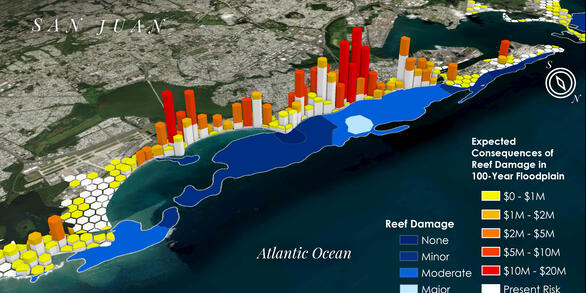Publications
Scientific reports, journal articles, and information products produced by USGS Pacific Coastal and Marine Science Center scientists.
Filter Total Items: 1381
Oblique Aerial Photography of the Arctic Coast of Alaska, Nulavik to Demarcation Point, August 7-10, 2006
The Arctic Coastal Plain of northern Alaska, an area of strategic economic importance to the United States, is home to remote Native American communities and encompasses unique habitats of global significance. Coastal erosion along the Arctic coast is chronic and widespread; recent evidence suggests that erosion rates are among the highest in the world (up to ~16 m/yr) and may be...
Authors
Ann Gibbs, Bruce M. Richmond
Examining Submarine Ground-Water Discharge into Florida Bay by using 222Rn and Continuous Resistivity Profiling
Estimates of submarine ground-water discharge (SGD) into Florida Bay remain one of the least understood components of a regional water balance. To quantify the magnitude and seasonality of SGD into upper Florida Bay, research activities included the use of the natural geochemical tracer, 222Rn, to examine potential SGD hotspots (222Rn surveys) and to quantify the total (saline + fresh...
Authors
Peter W. Swarzenski, Chris D. Reich, David T. Rudnick
Coastal Processes Study of Santa Barbara and Ventura Counties, California
The Santa Barbara littoral cell (SBLC) is a complex coastal system with significant management challenges. The coastline ranges broadly in exposure to wave energy, fluvial inputs, hard structures, and urbanization. Geologic influence (structural control) on coastline orientation exerts an important control on local beach behavior, with anthropogenic alterations and the episodic nature of...
Authors
Patrick L. Barnard, David L. Revell, Dan Hoover, Jonathan Warrick, John Brocatus, Amy E. Draut, Pete Dartnell, Edwin PL Elias, Neomi Mustain, Pat E. Hart, Holly F. Ryan
The performance of nearshore dredge disposal at Ocean Beach, San Francisco, California, 2005-2007
Ocean Beach, California, contains an erosion hot spot in the shadow of the San Francisco ebb tidal delta that threatens valuable public infrastructure as well as the safe recreational use of the beach. In an effort to reduce the erosion at this location a new plan for the management of sediment dredged annually from the main shipping channel at the mouth of San Francisco Bay was...
Authors
Patrick L. Barnard, Li Erikson, Jeff E. Hansen, Edwin PL Elias
Investigation of coastal hydrogeology utilizing geophysical and geochemical tools along the Broward County coast, Florida
Geophysical (CHIRP, boomer, and continuous direct-current resistivity) and geochemical tracer studies (continuous and time-series 222Radon) were conducted along the Broward County coast from Port Everglades to Hillsboro Inlet, Florida. Simultaneous seismic, direct-current resistivity, and radon surveys in the coastal waters provided information to characterize the geologic framework and...
Authors
Christopher D. Reich, Peter W. Swarzenski, W. Jason Greenwood, Dana S. Wiese
Radiocarbon ages and age models for the past 30,000 years in Bear Lake, Utah and Idaho
Radiocarbon analyses of pollen, ostracodes, and total organic carbon (TOC) provide a reliable chronology for the sediments deposited in Bear Lake over the past 30,000 years. The differences in apparent age between TOC, pollen, and carbonate fractions are consistent and in accord with the origins of these fractions. Comparisons among different fractions indicate that pollen sample ages...
Authors
Steve M. Colman, Robert J. Rosenbauer, Darrell S. Kaufman, Walter E. Dean, John P. McGeehin
Comparison of groundwater flow in Southern California coastal aquifers
Development of the coastal aquifer systems of Southern California has resulted in overdraft, changes in streamflow, seawater intrusion, land subsidence, increased vertical flow between aquifers, and a redirection of regional flow toward pumping centers. These water-management challenges can be more effectively addressed by incorporating new understanding of the geologic, hydrologic, and...
Authors
Randall T. Hanson, John A. Izbicki, Eric G. Reichard, Brian Edwards, Michael Land, Peter Martin
Linking human impacts within an estuary to ebb-tidal delta evolution
San Francisco Bay, California, USA is among the most anthropogenically altered estuaries in the entire United States, but the impact on sediment transport to the coastal ocean has not been quantified. Analysis of four historic bathymetric surveys has revealed large changes to the morphology of the San Francisco Bar, an ebb-tidal delta at the mouth of the San Francisco Bay. From 1873 to...
Authors
Kate L. Dallas, Patrick L. Barnard
Chapter 3 - Phenomenology of tsunamis: Statistical properties from generation to runup
Observations related to tsunami generation, propagation, and runup are reviewed and described in a phenomenological framework. In the three coastal regimes considered (near-field broadside, near-field oblique, and far field), the observed maximum wave amplitude is associated with different parts of the tsunami wavefield. The maximum amplitude in the near-field broadside regime is most...
Authors
Eric L. Geist
Littoral transport rates in the Santa Barbara Littoral Cell: a process-based model analysis
Identification of the sediment transport patterns and pathways is essential for sustainable coastal zone management of the heavily modified coastline of Santa Barbara and Ventura County (California, USA). A process-based model application, based on Delft3D Online Morphology, is used to investigate the littoral transport potential along the Santa Barbara Littoral Cell (between Point...
Authors
E. P. L. Elias, Patrick L. Barnard, John Brocatus
The observed relationship between wave conditions and beach response, Ocean Beach, San Francisco, CA
Understanding how sandy beaches respond to storms is critical for effective sediment management and developing successful erosion mitigation efforts. However, only limited progress has been made in relating observed beach changes to wave conditions, with one of the major limiting factors being the lack of temporally dense beach topography and nearshore wave data in most studies. This...
Authors
J.E. Hansen, P.L. Barnard
Multiple origins of linear dunes on Earth and Titan
Dunes with relatively long and parallel crests are classified as linear dunes. On Earth, they form in at least two environmental settings: where winds of bimodal direction blow across loose sand, and also where single-direction winds blow over sediment that is locally stabilized, be it through vegetation, sediment cohesion or topographic shelter from the winds. Linear dunes have also...
Authors
David M. Rubin, Patrick A. Hesp



